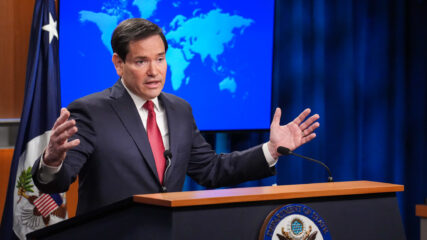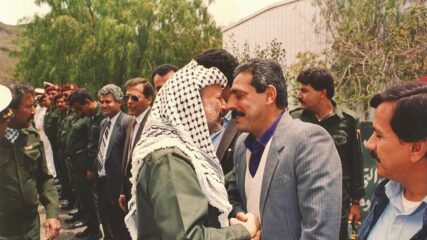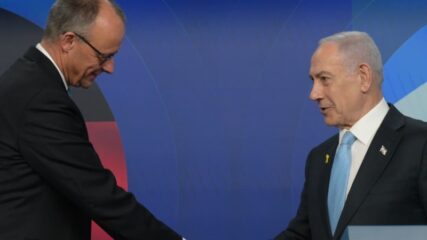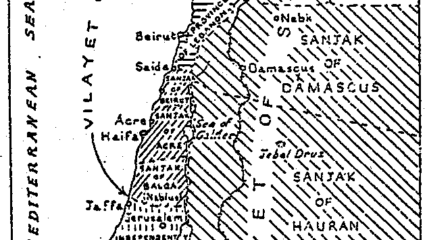Some ancestors of modern Palestinians and Israeli Arabs, like those of Israeli Jews, lived in the Land of Israel millennia ago, but most came to the area when Muhammad’s successors took Jerusalem and settled there from 636 forward. For centuries, tax farmers and later urban notables controlled most of the scarce cultivable land in the coastal plain and valley regions. The majority-Arab population engaged in subsistence agriculture and lived mostly in the central mountain range, stretching from the Galilee in the north through what is present-day Nablus, Ramallah, Jerusalem, Bethlehem and Hebron to the south.
Over time, a distinct social hierarchy evolved, in which a small number of families, clans, landowners, grain merchants, rural sheiks, moneylenders and urban notables controlled most local politics. Landowners usually lived far from their holdings, managing them through intermediaries who collected the yields, rents, taxes and usually exorbitant debts. Well before modern Zionism, Arab landlord-peasant relationships in the area of Palestine were tense.
Early immigrating Zionists settled in coastal and valley areas that were usually sparsely populated. Jewish writers and immigrants recognized that some local Arabs emphatically opposed their presence. Intense opposition to Zionist growth in Palestine and British support for the establishment of a Jewish national home gradually crystallized the Palestinian Arab National Movement. Jewish immigration, institution building and land purchases led the Palestinian leadership to boycott any cooperation with the British. Arab fervor against the Jewish national home culminated in periodic communal clashes, including 1921, 1928, 1929, and the prolonged 1936-1939 Arab Revolt against Zionism and British administration.
The revolt had a major impact on the Arab community itself. The British cracked down harshly on Arab rioters, expelled many Arab leaders from Palestine, and suspended Jewish physical and demographic growth in favor of the Palestinian Arabs. Having taken place mostly in the countryside, the revolt had the unintended consequence of devastating the Arab agricultural economy for the next decade. Furthermore, the British effort to stop Jewish land acquisition failed. As one British official said in 1940, “We need not have too much sympathy with the Arabs who make a practice of selling their lands to Jews. … The Arab landowner [needs] to be protected against himself.”
Zionists saw their vulnerability to attack and upgraded their self-defense organizations, taking stridently more aggressive actions against the Arabs for the remainder of the 1940s. The Arab Revolt proved to many Zionists that a compromise with Arab leadership for each community to have a part of Palestine west of the Jordan River might not work out.
When the British civilian administration began in 1920, the Arab population made up 90% of the total. By 1948, when the State of Israel was established, Arabs constituted two-thirds of the population west of the Jordan River, what was designated as the Palestine Mandate. After the 1948 War of Independence, which the Arabs call the nakbah or disaster, 700,000 Arabs fled, leaving an Arab minority of 20% in the new Jewish state. Of surrounding Arab states, only Jordan ultimately provided Palestinians with citizenship, with many participating in Jordanian political life and governance under Emir Abdullah and his grandson King Hussein.
After the June 1967 war, 4.2 million Arabs lived in the West Bank, the Gaza Strip and Jerusalem. By 2024, Arabs (Christian, Druze and Muslim) constituted about 23% of Israel’s population of 9.2 million. Most of the Arab inhabitants of Israel have Israeli citizenship and struggle with a sharp identity crisis between allegiance to Palestinian Arab nationalism and loyalty to the State of Israel. A vast majority of the Arabs living in Israel benefit from the Israeli health system and access to almost free education.
Already in the 1940s, Palestinian Arab politics was dysfunctional. Physical and geographic displacement of the Palestinians to the West Bank, the Gaza Strip and surrounding Arab states in the 1947-49 period further divided the sociologically and politically splintered Palestinian Arab population. For their own purposes, Egypt, Iraq and Syria, as well as the Soviet Union, either created or supported small Palestinian organizations in the hope that each of them would be able to influence Palestinian Arab policies during the second half of the 20th century. In 1964, a small number of Palestinians living in Kuwait established the secular Palestine Liberation Organization. An umbrella organization, the PLO was made up of half a dozen small groups whose objective was Israel’s destruction through armed struggle. The PLO and other Palestinian organizations, especially after Israel’s defeat of Arab countries (Egypt, Syria and Jordan) in the June 1967 war, intensified terrorist attacks again Israeli civilians and Jewish institutions worldwide. After Egypt signed a peace treaty with Israel in 1979, the PLO vowed to avenge the recognition of Israel, and two years later Egyptian President Anwar Sadat was assassinated.
In 1988, Hamas, a Palestinian group with a radical Islamic orientation, organized itself in Gaza and published a charter calling for Israel’s destruction, the liberation of Palestine, and over time the killing of all Jews. Hamas sought to ethnically cleanse the land west of the Jordan River of all Jews through jihad.
Nonetheless, in 1993 the PLO and Israel recognized each other, but no Palestinian state was sought or promised or emerged. In October 2023, Hamas, having won legislative elections in 2006 and seized control of the Gaza Strip from the Palestinian Authority and the PLO’s Fatah party in 2007, attacked southern Israeli villages and kibbutzim, murdered more than 1,200 Israelis and others, and took 250 hostages to Gaza. The ensuing 15 months saw fierce battles between Israeli soldiers and Hamas fighters, killing tens of thousands.
While many voices outside the Palestine/Israel area regularly call for the establishment of two states for two peoples, Israeli and Palestinian majorities do not support that idea. Many believe that neither side wishes to compromise with the other on such issues as the prerogatives of a Palestinian state, its borders, the future of Jewish settlements, refugees who might wish to return to the West Bank and to Israel proper, the status of Jerusalem, economics and water, and even the possibility of ending the conflict between Arabs and Israelis through diplomacy. Hamas refuses to recognize any diplomatic action or agreement that accepts Israel as a reality. No Palestinian Arab leader has ever promised to end the conflict with Israel.
Israel’s 1948 Declaration of Independence called for peaceful coexistence between Jews and Arabs. Though 150,000 Arabs remained in Israel as citizens after the War of Independence, they faced residential and economic restrictions until 1966. Arabs in Israel feel discriminated against by the majority Jewish population because the state has periodically confiscated Arab lands and because tax revenues are not equitably distributed between Jewish and Arab municipalities. While Arabs in the West Bank and Gaza rioted against Israeli control of those areas during the intifadas of 1987 to 1991 and 2000 to 2004, Israeli Arabs protested for better treatment from government ministries. Israeli Arabs have shown passionate support for the Palestinian cause. Israel has almost 150,000 Druze citizens, who speak Arabic but, unlike the general Israeli Arab population, serve in the Israeli army and in high political and diplomatic positions.
Over the last century, Palestinian Arab leaders have typically maintained rigid autocratic control over their rank and file (Hajj Amin al-Husseini, Yasser Arafat, Mahmoud Abbas). Palestinian Arabs have made little effort to establish civil society or self-empowerment, even with Israel holding tightly to the administration of the West Bank. But Arabs have been elected to the Israeli parliament, the Knesset, since the first election in 1949. Overall, Arabs have held 10% of Knesset seats. Israeli Arabs have held positions on the Supreme Court and in the diplomatic corps but rarely in the Cabinets of ruling coalitions. The Israeli Supreme Court has consistently ruled in favor of equal citizenship and opportunity rights for Israeli Arabs.
Still, many Arabs of Palestine feel unfulfilled politically. They seek a political entity in which they can express self-determination and politicians cannot ignore their voices, whether their own leaders or external powers that seek to shape or deny their future. In 2025, virtually all Palestinians agree that their leadership is riven with ideological and geographic division and is overwhelmingly autocratic, hierarchical and sclerotic. Over the past five years, surveys by the Palestinian Center for Policy and Survey Research repeatedly have revealed poor or inept Palestinian self-governing institutions and deep structural crises in the Ramallah administration. Perhaps at no time in the history of the Palestinian national movement have Arabs who identify as Palestinians been as divided. But while many yearn for that place or state of their own, Israelis, particularly after the Hamas attack of October 2023, remain highly skeptical about trusting any Palestinian self-rule in any portion of the land west of the Jordan River.
Key Documents
1931 Census for Palestine — Gaping Socio-Economic Differences
1939 Mufti Hajj Amin Al Husseini Rejects a Majority-Arab Palestinian State
1945-1949 Reasoned Views for Palestinian Arabs’ Dysfunctional Condition
1946 The Arab Case for Palestine
1947 Abdulrahman ‘Azzam Pasha Rejects Any Compromise With Zionists
1948 U.N. General Assembly Resolution 194 Concerning Palestinian Refugees
1964 PLO National Covenant
1988 Hamas Charter, Islamic Resistance Movement of Palestine
1993 Israel-PLO Mutual Recognition Letters
1993 Oslo Accords: Declaration of Principles on Interim Self-Government Agreements
2023 Hamas Sources Expressing Hatred for Zionism, Israel and Jews, 1988-Present
2025 Mixed Muslim and Arab Views Toward Jews, Arabs and Zionism 1920s-Present









